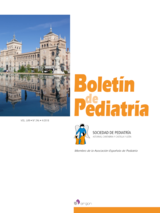Patología quirúrgica hepatobiliar en la infancia
O. Gómez Beltrán , V. Alonso Arroyo , M.E. Molina Vázquez , I. Carrillo Arroyo , A. Sánchez Abuín
Bol. Pediatr. 2018; 58 (246): 250 - 258
La patología quirúrgica hepatobiliar en la infancia posee una gran relevancia debido a la repercusión que presenta en los niños afectados, razón por la que el correcto conocimiento de la misma se correlaciona con un diagnóstico temprano y un manejo oportuno que redunda en beneficio para nuestros pacientes. la presente revisión es una actualización centrada en las cuatro principales patologías hepatobiliares pediátricas. en primer lugar, se considera la atresia de vías biliares (aVB), que es la causa quirúrgica más común de enfermedad colestásica neonatal y la primera indicación de trasplante hepático infantil. es de resaltar la evolución en el concepto de la aVB en la última década, que recientemente se ha definido como un fenotipo caracterizado por la obliteración o ausencia de las vías biliares extrahepáticas, asociado a una alteración en la formación de los conductos biliares intrahepáticos, que puede deberse a múltiples etiologías. en segundo lugar, se revisa la dilatación de la vía biliar extrahepática y/o intrahepática, que afecta con mayor frecuencia al colédoco, conocida como quiste de colédoco. Se hace énfasis en su clasificación anatómica y etiológica, en el papel relevante de la colangiorresonancia en la evaluación preoperatoria de la lesión y en el tratamiento oportuno en función del tipo de dilatación y de la condición clínica del niño. en tercer lugar, se analiza el incremento de la presión del sistema venoso portal, denominado como hipertensión portal. dicho aumento de presión puede encontrar su origen en una obstrucción venosa a nivel prehepático, hepático y posthepático. Se destaca la singularidad de la hipertensión portal en la infancia que, a diferencia de los adultos, muestran una gran proporción de pacientes con una causa prehepática, los cuales desarrollan hiperesplenismo y hemorragia secundaria a várices esofagogástricas con mayor frecuencia, pero con una baja mortalidad atribuible a dicha hemorragia y ausencia de progresión a cirrosis hepática. Finalmente, se habla de la litiasis biliar en la infancia, destacando el amplio espectro clínico que presentan los niños afectados y la variedad en la composición de los cálculos biliares en pediatría, remarcando las estrategias terapéuticas a seguir en cada caso.
Pediatric hepatobiliary surgery pathology
Pediatric hepatobiliary surgery pathology is of great relevance due to its repercussion in the affected children. For this reason, correct knowledge about it is correlated with an early diagnosis and pertinent management that results in a benefit for our patients. This review is an update focused on the four main pediatric hepatobiliary pathologies. Bile duct atresia (BVA) is considered in the first place, this being the most common surgical cause of neonatal cholestatic disease and the first indication of child liver transplant. the evolution in the concept of BVa in the last decade should be emphasized, which has recently been defined as a phenotype characterized by the obliteration or absence of the extrahepatic bile ducts, associated to an alteration in the formation of the intrahepatic bile ducts, which can be due to multiple etiologies. in the second place, dilatation of the extrahepatic and/or intrahepatic bile ducts, that with greater frequency affects the choledoch, known as choledochal cyst, is reviewed. emphasis is placed on their anatomical and etiological classification, on the relevant role of the cholangioresonance in the pre-operative evaluation of the lesion and on the pertinent treatment based on the type of dilatation and on the clinical condition of the child. in the third place, an analysis is made of the increase of the pressure of the portal venous system, called portal hypertension. Said increase in pressure can originate in a venous obstruction on the prehepatic, hepatic or post-hepatic level. the singularity of portal hypertension in children stands out which, on the contrary to in adults, shows a large proportion of patients with a prehepatic cause, these developing hypersplenism and hemorrhaging secondary to esophagogastric varices more frequently. However, they have a low mortality attributable to said hemorrhaging and absence of progression to hepatic cirrhosis. Finally, mention is made of gallstones in children, stressing the wide clinical spectrum that the affected children have and the variety in the composition of the gallstones in pediatrics, emphasizing the therapeutic strategies to follow in each case.
Artículo completo (PDF) (255 kb.)
- Cirugía
Buscar en el boletín
Año 2018, Volumen 58, Número 246

Boletín completo en PDF (1396 kb.)